Sizing and Sitting of DERs in Active Distribution Networks Incorporating Load Prevailing Uncertainties Using Probabilistic Approaches
Abstract
1. Introduction
2. Problem Outlines
2.1. Microgrid’s Demand
2.2. Microgrid’s Supply Strategy
2.2.1. Enjoying Photovoltaic Panel’s Power
- If the PV generation is more than the grid’s demand and the batteries are not fully charged, the excess PV generation should be stored in the batteries;
- If the PV generation is more than the grid’s demand and the batteries are fully charged, the excess generation of PV panels must be sold to the distribution network;
- If the PV generation is lower than the grid’s demand, a portion of the loads will be supplied through PV generation, and the rest of the demand must be procured through the energy storage system;
- If the PV generation is lower than the grid’s demand and the battery system is not adequate to supply the loads entirely, the loads will be satisfied by PV panels and energy storage units as much as possible, and the rest of the loads must be met by the diesel generator;
- If the total generation by PV panels, batteries, and the diesel generator is not sufficient for satisfying the load, the load-shedding measure must be imposed for the excessive demand.
2.2.2. Being Deprived of PV Generation
- If the batteries’ capacity is adequate to supply the demand, the loads will be served by the batteries solely;
- If the batteries’ capacity is not sufficient to supply the demand, the rest of the loads must be served by the diesel generator;
- If the demand is more than the combined capacity of PV panels and the diesel generator, the rest of the loads must be remained unsupplied by load shedding.
2.3. The Objective Function
2.3.1. Power Losses
2.3.2. The Cost Related to the Photovoltaic System
2.3.3. The Battery Cost
2.3.4. The Cost Pertaining to Diesel Generator
2.3.5. The Cost Pertaining to Load Shedding
2.3.6. The Profit Yielded by Excess Generation Selling
2.3.7. Constraints
2.3.8. The Uncertainty Modeling for PV Sources
2.3.9. Load Forecast Uncertainty
2.4. Energy Management Paradigm by Microgrid’s Controller
3. Lightning Attachment Procedure Optimization (LAPO) Method
3.1. Initialization
3.2. The Next Jumping Node
3.3. Streaming Forward and Elimination of Branches
3.4. Upward Leader Propagation
3.5. Convergence
4. Simulation and Results
4.1. The IEEE Test Systems (33-Bus and 69-Bus)
4.2. Incorporation of Uncertainty in the Model
- Step 1—Generation of 1000 samples for each uncertain optimization variable.
- Step 2—The stochastic generation of a set of solutions for optimization variables.
- Step 3—The selection of a set of optimization variables.
- Step 4—Test the grid’s performance for 1000 samples using the Monte Carlo approach and checking all constraints for 1000 plausible scenarios.
- Step 5—The calculation of the objective function (if the constraints are met).
- Step 6—Check convergence and termination conditions. If it is converged, then go to step 9.
- Step 7—The change of optimization variables based on the optimization method.
- Step 8—Go to step 3.
- Step 9—End.
5. Conclusions
Author Contributions
Funding
Institutional Review Board Statement
Informed Consent Statement
Conflicts of Interest
References
- Gil-González, W.; Garces, A.; Montoya, O.D.; Hernández, J.C. A Mixed-Integer Convex Model for the Optimal Placement and Sizing of Distributed Generators in Power Distribution Networks. Appl. Sci. 2021, 11, 627. [Google Scholar] [CrossRef]
- Nafisi, H.; Agah, S.M.M.; Abyaneh, H.A.; Abedi, M. Two-Stage Optimization Method for Energy Loss Minimization in Microgrid Based on Smart Power Management Scheme of PHEVs. IEEE Trans. Smart Grid 2015, 7, 1268–1276. [Google Scholar] [CrossRef]
- Nafisi, H.; Farahani, V.; Abyaneh, H.A.; Abedi, M. Optimal daily scheduling of reconfiguration based on mini-misation of the cost of energy losses and switching operations in microgrids. IET Gener. Transm. Distrib. 2015, 9, 513–522. [Google Scholar] [CrossRef]
- Hosseini, S.J.A.D.; Moradian, M.; Shahinzadeh, H.; Ahmadi, S. Optimal Placement of Distributed Generators with Regard to Reliability Assessment using Virus Colony Search Algorithm. Int. J. Renew. Energy Res. 2018, 8, 714–723. [Google Scholar]
- Hamzeh, M.; Vahidi, B.; Nematollahi, A.F. Optimizing Configuration of Cyber Network Considering Graph Theory Structure and Teaching-Learning-Based Optimization (GT-TLBO). IEEE Trans. Ind. Inform. 2018, 15, 2083–2090. [Google Scholar] [CrossRef]
- Thatte, A.A.; Xie, L. Towards a Unified Operational Value Index of Energy Storage in Smart Grid Environment. IEEE Trans. Smart Grid 2012, 3, 1418–1426. [Google Scholar] [CrossRef]
- Das, T.; Krishnan, V.; McCalley, J.D. Assessing the benefits and economics of bulk energy storage technologies in the power grid. Appl. Energy 2015, 139, 104–118. [Google Scholar] [CrossRef]
- Rahiminejad, A.; Aranizadeh, A.; Vahidi, B. Simultaneous distributed generation and capacitor placement and sizing in radial distribution system considering reactive power market. J. Renew. Sustain. Energy 2014, 6, 43124. [Google Scholar] [CrossRef]
- Moazzami, M.; Gharehpetian, G.B.; Shahinzadeh, H.; Hosseinian, S.H. Optimal locating and sizing of DG and D-STATCOM using Modified Shuffled Frog Leaping Algorithm. In Proceedings of the 2017 2nd Conference on Swarm Intelligence and Evolutionary Computation (CSIEC), Kerman, Iran, 7–9 March 2017; Institute of Electrical and Electronics Engineers (IEEE): Piscataway, NJ, USA, 2017; pp. 54–59. [Google Scholar]
- Karunarathne, E.; Pasupuleti, J.; Ekanayake, J.; Almeida, D. Optimal Placement and Sizing of DGs in Distribution Networks Using MLPSO Algorithm. Energies 2020, 13, 6185. [Google Scholar] [CrossRef]
- Cho, B.; Ryu, K.; Park, J.; Moon, W.; Cho, S.; Kim, J. A Selecting Method of Optimal Load on Time Varying Distribution System for Network Reconfiguration considering DG. J. Int. Counc. Electr. Eng. 2012, 2, 166–170. [Google Scholar] [CrossRef]
- Aman, M.; Jasmon, G.; Bakar, A.; Mokhlis, H. A new approach for optimum simultaneous multi-DG distributed generation Units placement and sizing based on maximization of system loadability using HPSO (hybrid particle swarm optimization) algorithm. Energy 2014, 66, 202–215. [Google Scholar] [CrossRef]
- Ameli, A.; Bahrami, S.; Khazaeli, F.; Haghifam, M.-R. A multiobjective particle swarm optimization for sizing and placement of DGs from DG owner’s and distribution company’s viewpoints. IEEE Trans. Power Deliv. 2014, 29, 1831–1840. [Google Scholar] [CrossRef]
- Buaklee, W.; Hongesombut, K. Optimal DG Placement in a Smart Distribution Grid Considering Economic As-pects. J. Electr. Eng. Technol. 2014, 9, 1240–1247. [Google Scholar] [CrossRef]
- Wang, Z.; Chen, B.; Wang, J.; Kim, J.; Begovic, M.M. Robust Optimization Based Optimal DG Placement in Microgrids. IEEE Trans. Smart Grid 2014, 5, 2173–2182. [Google Scholar] [CrossRef]
- Alotaibi, M.; Almutairi, A.; Salama, M. Effect of wind turbine parameters on optimal DG placement in power dis-tribution systems. In Proceedings of the 2016 IEEE Electrical Power and Energy Conference (EPEC), Ottawa, ON, Canada, 12–14 October 2016; Institute of Electrical and Electronics Engineers (IEEE): Piscataway, NJ, USA, 2016. [Google Scholar]
- Hengsritawat, V.; Tayjasanant, T.; Nimpitiwan, N. Optimal sizing of photovoltaic distributed generators in a dis-tribution system with consideration of solar radiation and harmonic distortion. Int. J. Electr. Power Energy Syst. 2012, 39, 36–47. [Google Scholar] [CrossRef]
- Carpentiero, V.; Langella, R.; Testa, A. Hybrid wind-diesel stand-alone system sizing accounting for component expected life and fuel price uncertainty. Electr. Power Syst. Res. 2012, 88, 69–77. [Google Scholar] [CrossRef]
- Hakimi, S.M.; Moghaddas-Tafreshi, S.M. Optimal sizing of a stand-alone hybrid power system via particle swarm optimization for Kahnouj area in south-east of Iran. Renew. Energy 2009, 34, 1855–1862. [Google Scholar] [CrossRef]
- Ma, T.; Yang, H.; Lu, L. A feasibility study of a stand-alone hybrid solar-wind-battery system for a remote island. Appl. Energy 2014, 121, 149–158. [Google Scholar] [CrossRef]
- Hassan, A.S.; Sun, Y.; Wang, Z. Multi-objective for optimal placement and sizing DG units in reducing loss of power and enhancing voltage profile using BPSO-SLFA. Energy Rep. 2020, 6, 1581–1589. [Google Scholar] [CrossRef]
- Reddy, P.D.P.; Reddy, V.V.; Manohar, T.G. Ant Lion optimization algorithm for optimal sizing of renewable energy resources for loss reduction in distribution systems. J. Electr. Syst. Inf. Technol. 2018, 5, 663–680. [Google Scholar] [CrossRef]
- Alzahrani, A.; Alharthi, H.; Khalid, M. Minimization of power losses through optimal battery placement in a dis-tributed network with high penetration of photovoltaics. Energies 2020, 13, 140. [Google Scholar]
- Farh, H.M.H.; Al-Shaalan, A.M.; Eltamaly, A.M.; Al-Shamma’A, A.A. A Novel Crow Search Algorithm Auto-Drive PSO for Optimal Allocation and Sizing of Renewable Distributed Generation. IEEE Access 2020, 8, 27807–27820. [Google Scholar] [CrossRef]
- HassanzadehFard, H.; Jalilian, A. Optimal sizing and location of renewable energy based DG units in distribution systems considering load growth. Int. J. Electr. Power Energy Syst. 2018, 101, 356–370. [Google Scholar] [CrossRef]
- Hemeida, M.G.; Ibrahim, A.A.; Mohamed, A.-A.A.; Alkhalaf, S.; El-Dine, A.M.B. Optimal allocation of distributed generators DG based Manta Ray Foraging Optimization algorithm (MRFO). Ain Shams Eng. J. 2021, 12, 609–619. [Google Scholar] [CrossRef]
- Jalili, A.; Taheri, B. Optimal Sizing and Sitting of Distributed Generations in Power Distribution Networks Using Firefly Algorithm. Technol. Econ. Smart Grids Sustain. Energy 2020, 5, 1–14. [Google Scholar] [CrossRef]
- Lata, P.; Vadhera, S. Optimal placement and sizing of energy storage systems to improve the reliability of hybrid power distribution network with renewable energy sources. J. Stat. Manag. Syst. 2020, 23, 17–31. [Google Scholar] [CrossRef]
- Mukhopadhyay, B.; Das, D. Multi-objective dynamic and static reconfiguration with optimized allocation of PV-DG and battery energy storage system. Renew. Sustain. Energy Rev. 2020, 124, 109777. [Google Scholar] [CrossRef]
- Shahinzadeh, H.; Moradi, J.; Gharehpetian, G.B.; Nafisi, H.; Abedi, M. IoT Architecture for Smart Grids. In Proceedings of the 2019 International Conference on Protection and Automation of Power System (IPAPS), Tehran, Iran, 8–9 January 2019; Institute of Electrical and Electronics Engineers (IEEE): Piscataway, NJ, USA, 2019; pp. 22–30. [Google Scholar]
- Shahinzadeh, H.; Moradi, J.; Gharehpetian, G.B.; Nafisi, H.; Abedi, M. Internet of Energy (IoE) in Smart Power Systems. In Proceedings of the 2019 5th Conference on Knowledge Based Engineering and Innovation (KBEI), Tehran, Iran, 28–29 February 2019; Institute of Electrical and Electronics Engineers (IEEE): Piscataway, NJ, USA, 2019; pp. 627–636. [Google Scholar]
- Ebeed, M.; Ali, A.; Mosaad, M.I.; Kamel, S. An Improved Lightning Attachment Procedure Optimizer for Optimal Reactive Power Dispatch With Uncertainty in Renewable Energy Resources. IEEE Access 2020, 8, 168721–168731. [Google Scholar] [CrossRef]
- Youssef, H.; Kamel, S.; Ebeed, M. Optimal Power Flow Considering Loading Margin Stability Using Lightning Attachment Optimization Technique. In Proceedings of the 2018 Twentieth International Middle East Power Systems Conference (MEPCON, Nasr City, Egypt, 18–20 December 2018; Institute of Electrical and Electronics Engineers (IEEE): Piscataway, NJ, USA, 2018; pp. 1053–1058. [Google Scholar]
- Ramadan, A.; Ebeed, M.; Kamel, S.; Nasrat, L. Optimal Allocation of Renewable Energy Resources Considering Uncertainty in Load Demand and Generation. In Proceedings of the 2019 IEEE Conference on Power Electronics and Renewable Energy (CPERE), Aswan, Egypt, 23–25 October 2019; Institute of Electrical and Electronics Engineers (IEEE): Piscataway, NJ, USA, 2019; pp. 124–128. [Google Scholar]
- Ebeed, M.; Alhejji, A.; Kamel, S.; Jurado, F. Solving the Optimal Reactive Power Dispatch Using Marine Predators Algorithm Considering the Uncertainties in Load and Wind-Solar Generation Systems. Energies 2020, 13, 4316. [Google Scholar] [CrossRef]
- Ramadan, A.; Ebeed, M.; Kamel, S.; Nasrat, L. Optimal power flow for distribution systems with uncertainty. In Uncertainties in Modern Power Systems; Elsevier BV: Amsterdam, The Netherlands, 2021; pp. 145–162. [Google Scholar]
- Ebeed, M.; Aleem, S.H.E.A. Overview of uncertainties in modern power systems: Uncertainty models and methods. In Uncertainties in Modern Power Systems; Elsevier BV: Amsterdam, The Netherlands, 2021; pp. 1–34. [Google Scholar]
- Yang, Y.; Li, S.; Li, W.; Qu, M. Power load probability density forecasting using Gaussian process quantile regres-sion. Appl. Energy 2018, 213, 499–509. [Google Scholar] [CrossRef]
- Sirat, A.P.; Mehdipourpicha, H.; Zendehdel, N.; Mozafari, H. Sizing and Allocation of Distributed Energy Resources for Loss Reduction using Heuristic Algorithms. In Proceedings of the 2020 IEEE Power and Energy Conference at Illinois (PECI), Champaign, IL, USA, 20–21 February 2020; Institute of Electrical and Electronics Engineers (IEEE): Piscataway, NJ, USA, 2020; pp. 1–6. [Google Scholar]
- Nematollahi, A.F.; Rahiminejad, A.; Vahidi, B. A novel physical based meta-heuristic optimization method known as Lightning Attachment Procedure Optimization. Appl. Soft Comput. 2017, 59, 596–621. [Google Scholar] [CrossRef]
- Nematollahi, A.F.; Rahiminejad, A.; Vahidi, B.; Askarian, H.; Safaei, A. A new evolutionary-analytical two-step optimization method for optimal wind turbine allocation considering maximum capacity. J. Renew. Sustain. Energy 2018, 10, 043312. [Google Scholar] [CrossRef]
- Nematollahi, A.F.; Rahiminejad, A.; Vahidi, B. A novel multi-objective optimization algorithm based on Lightning Attachment Procedure Optimization algorithm. Appl. Soft Comput. 2019, 75, 404–427. [Google Scholar] [CrossRef]
- Nematollahi, A.F.; Dadkhah, A.; Gashteroodkhani, O.A.; Vahidi, B. Optimal sizing and siting of DGs for loss reduction using an iterative-analytical method. J. Renew. Sustain. Energy 2016, 8, 055301. [Google Scholar] [CrossRef]
- El-Zonkoly, A. Optimal placement of multi-distributed generation units including different load models using particle swarm optimization. Swarm Evol. Comput. 2011, 1, 50–59. [Google Scholar] [CrossRef]
- El-Zonkoly, A. Optimal placement and schedule of multiple grid connected hybrid energy systems. Int. J. Electr. Power Energy Syst. 2014, 61, 239–247. [Google Scholar] [CrossRef]
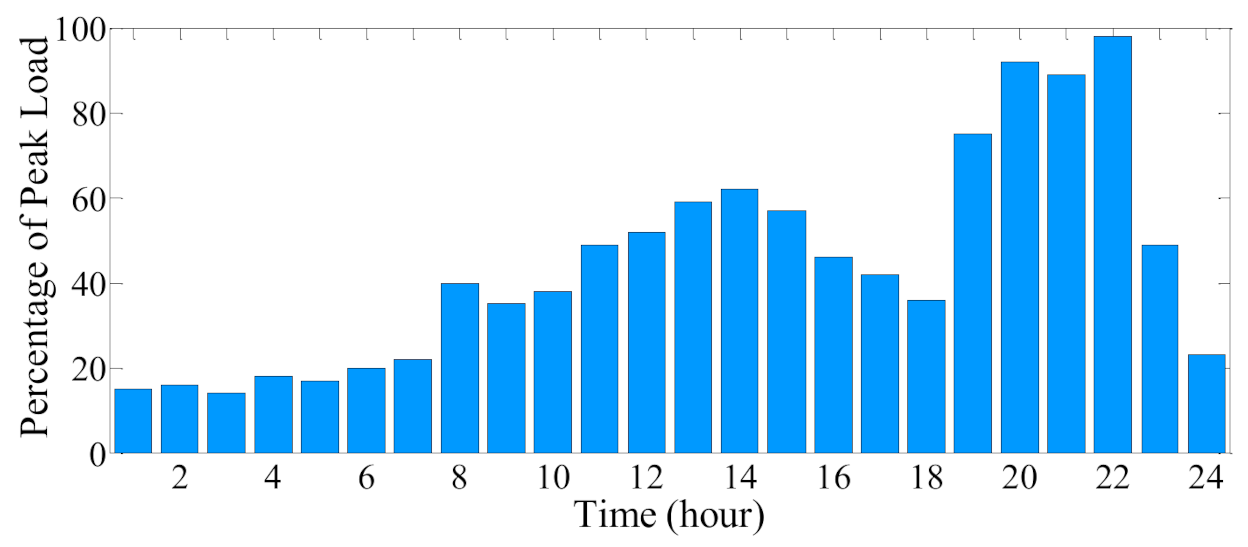
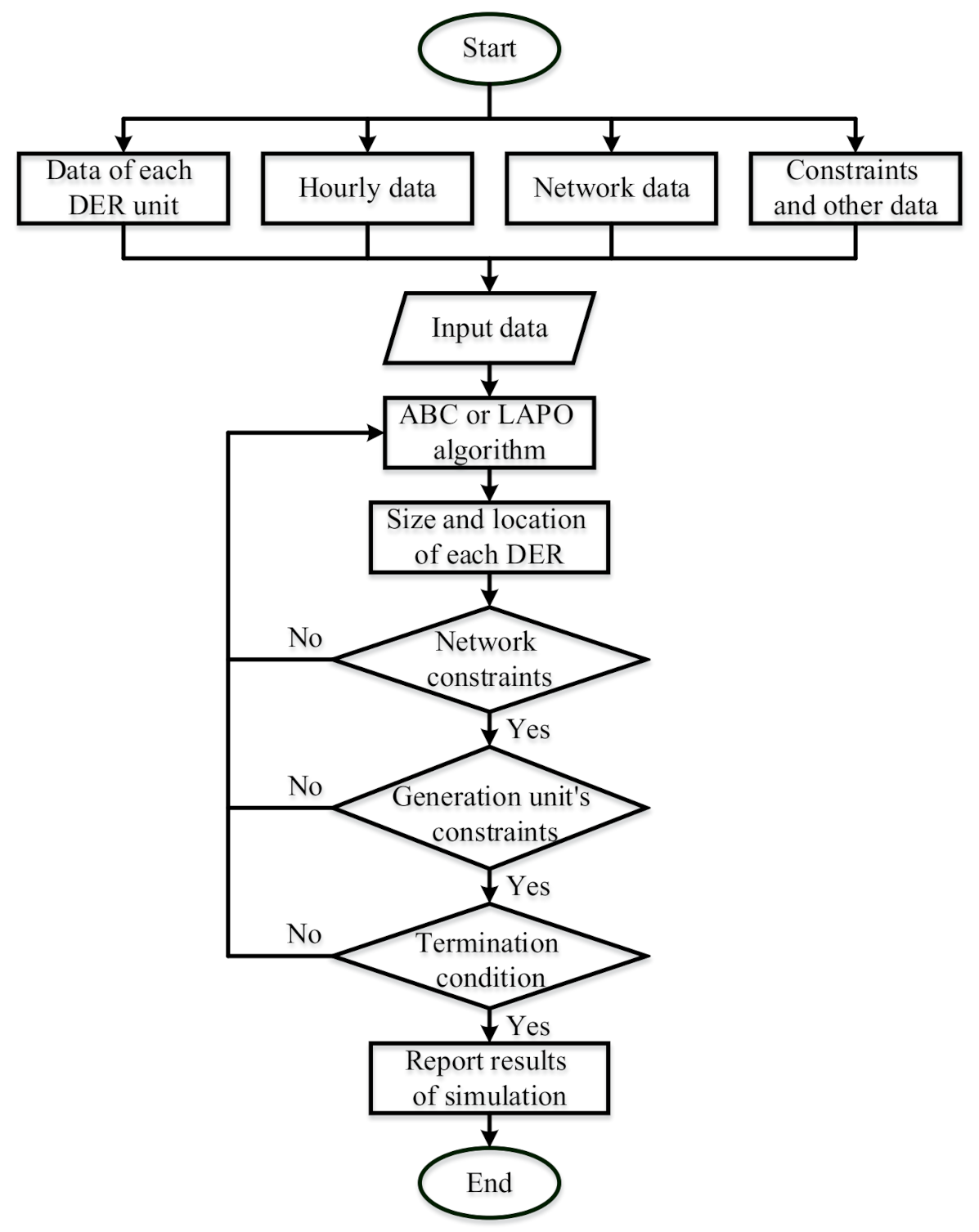


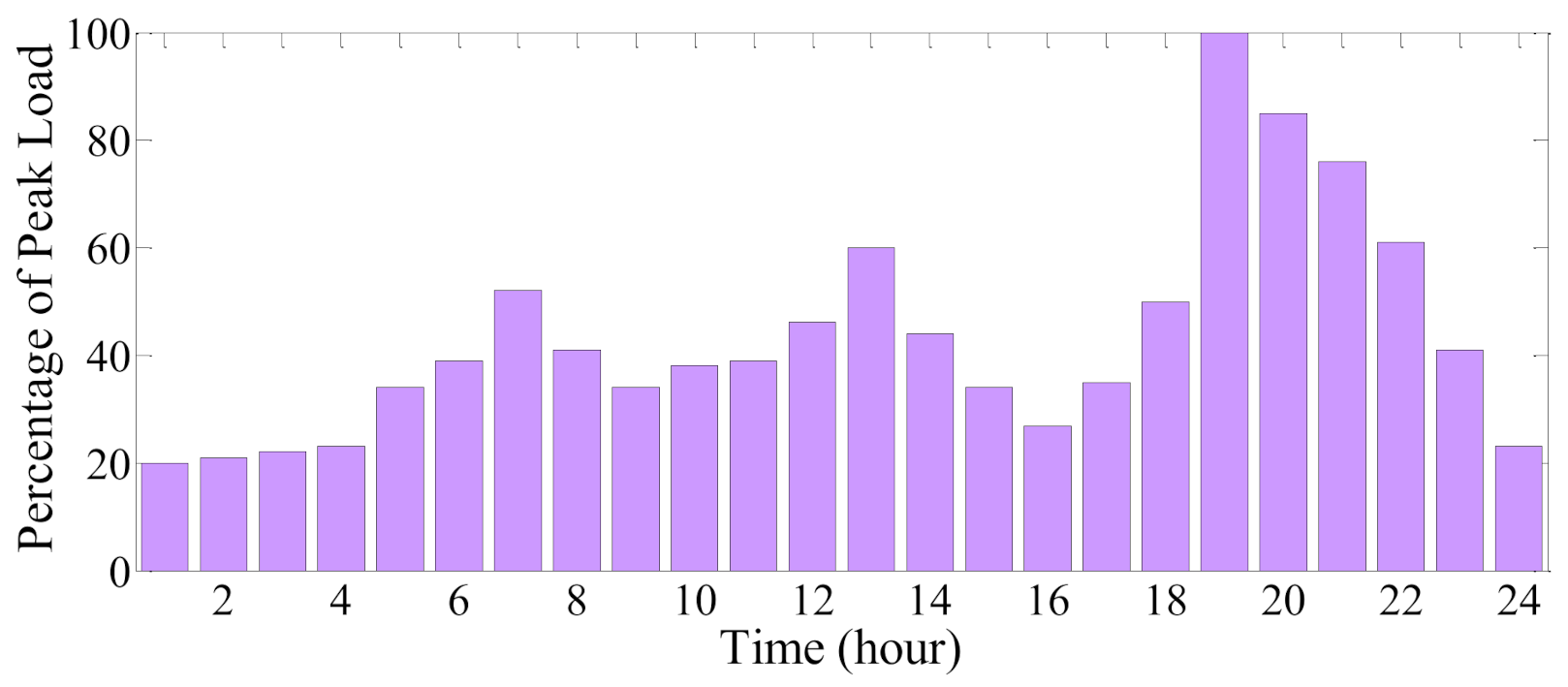
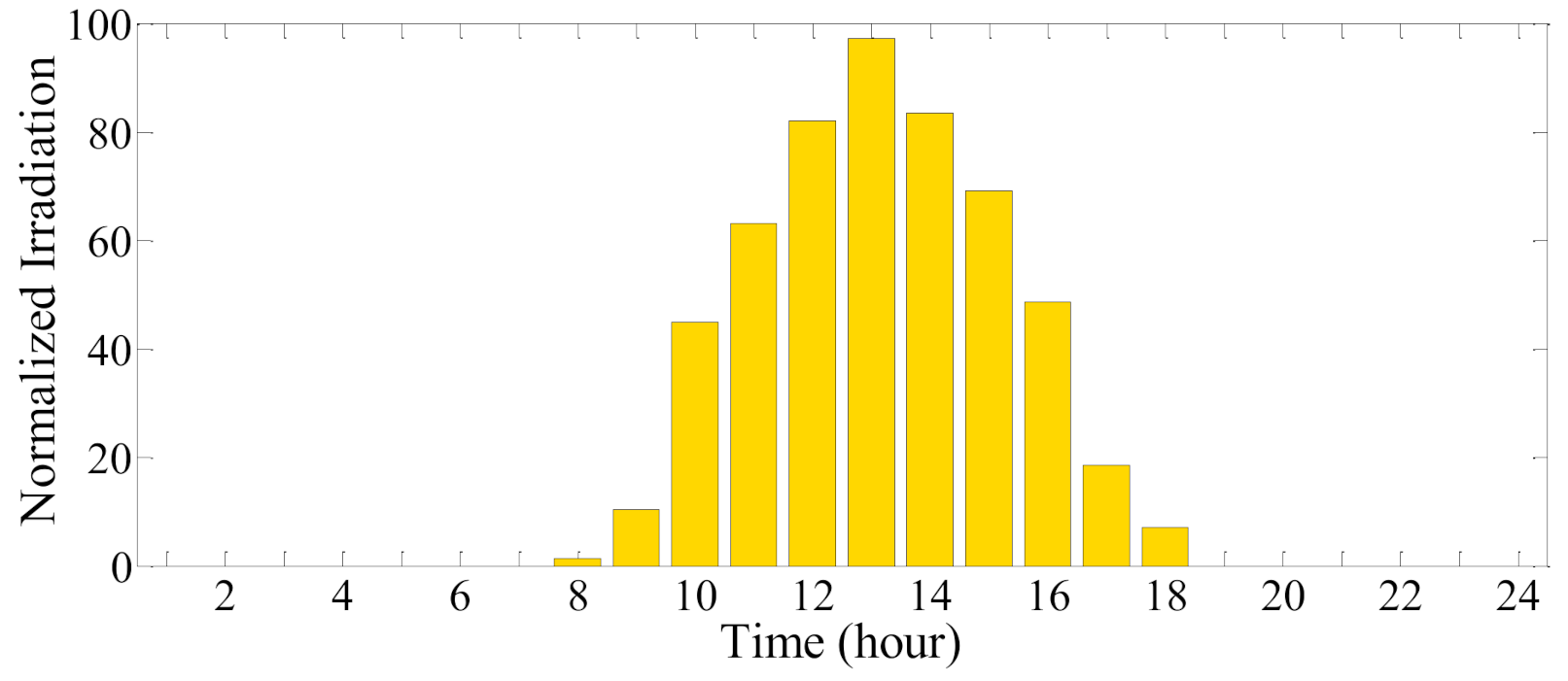
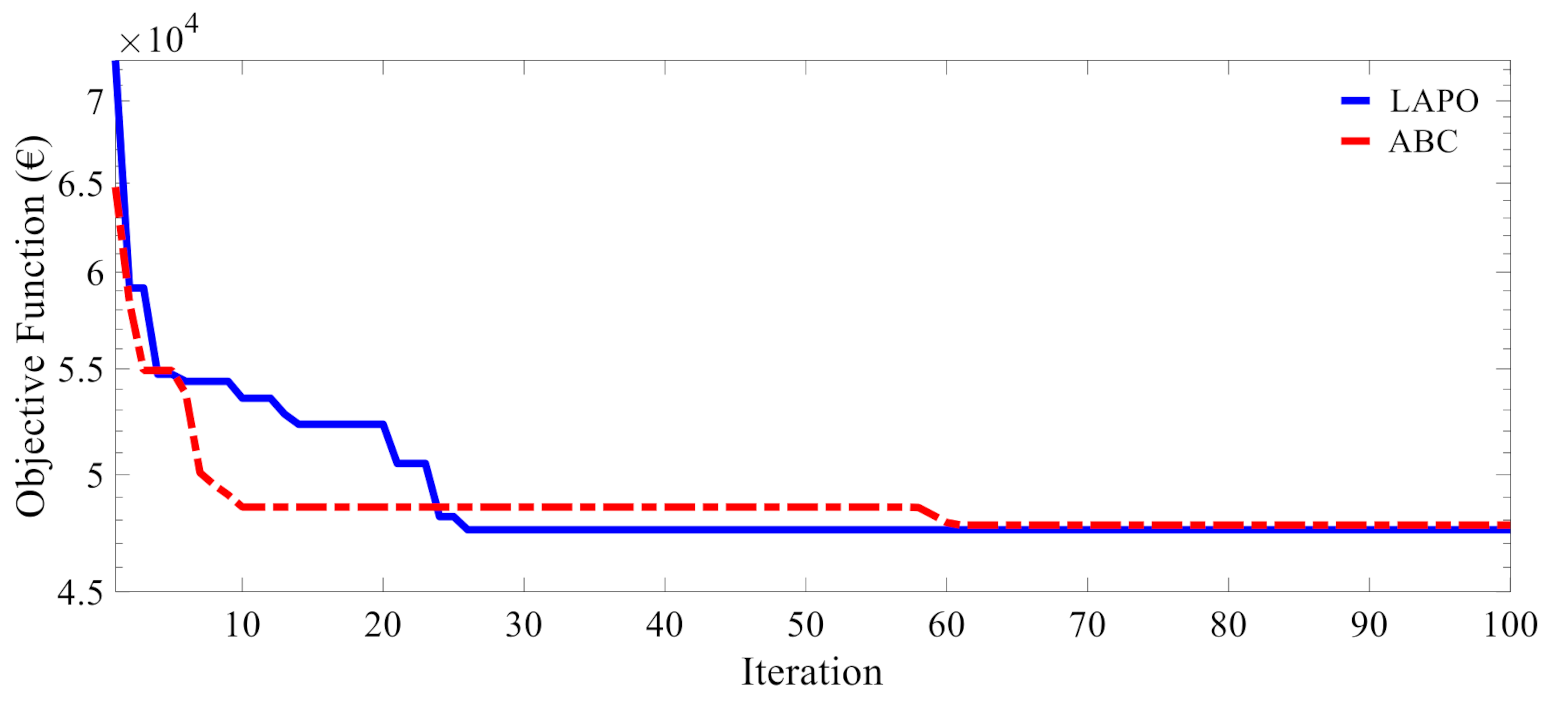
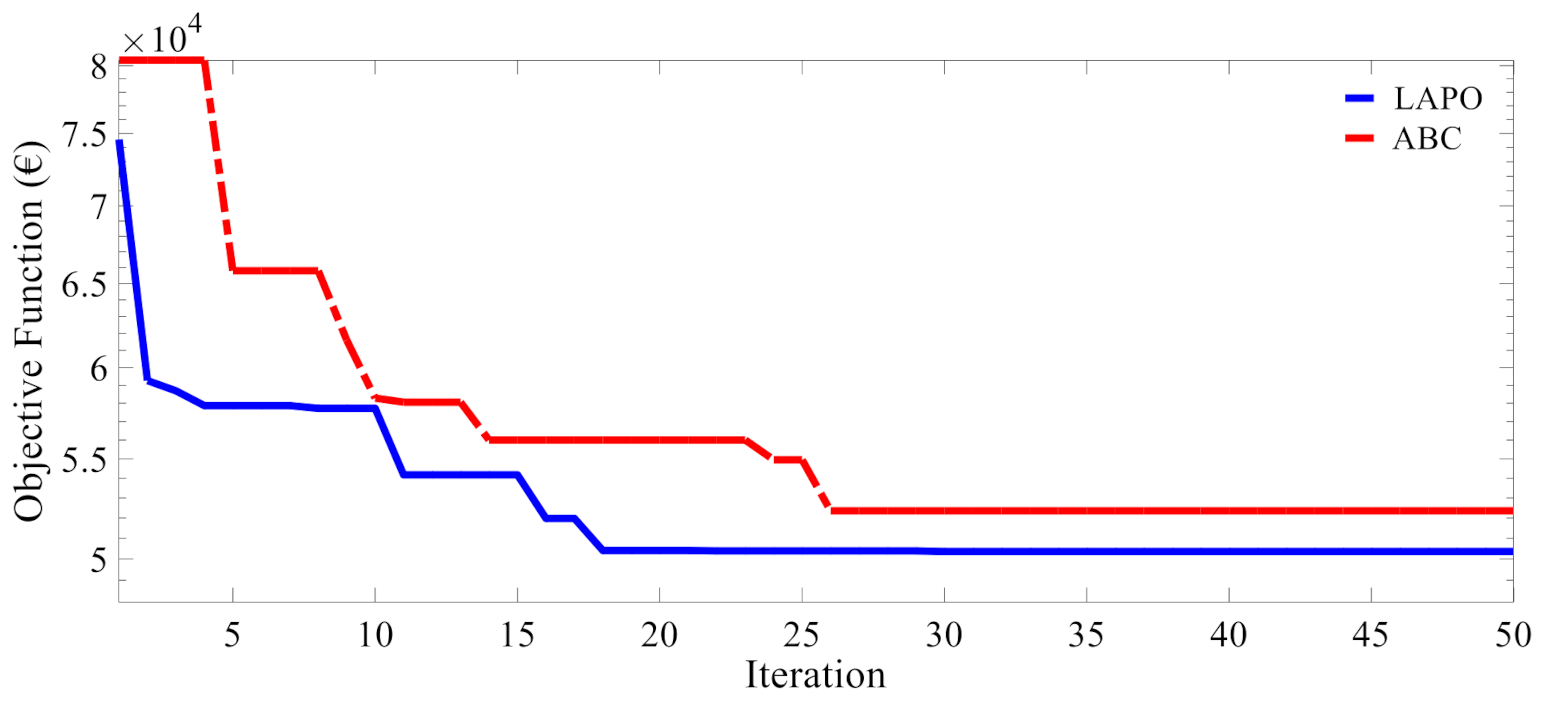
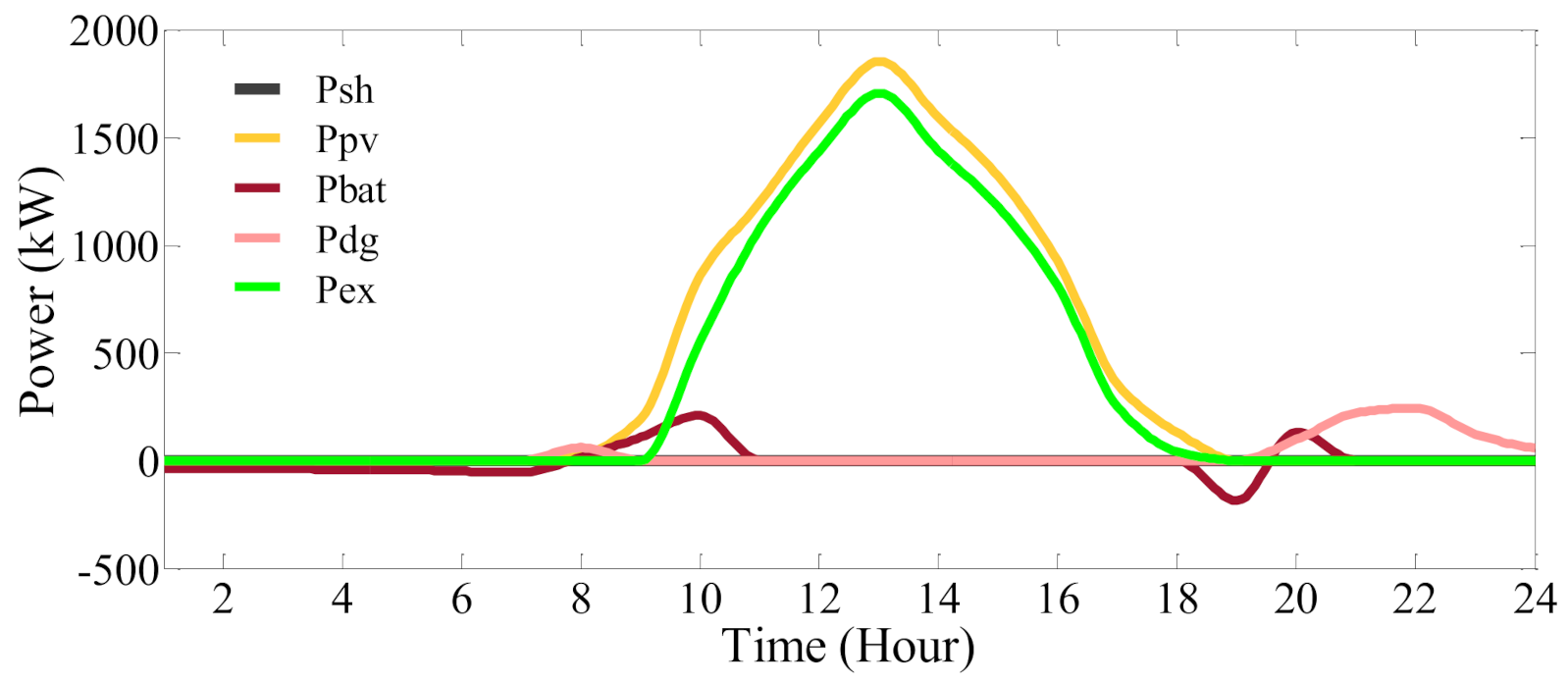
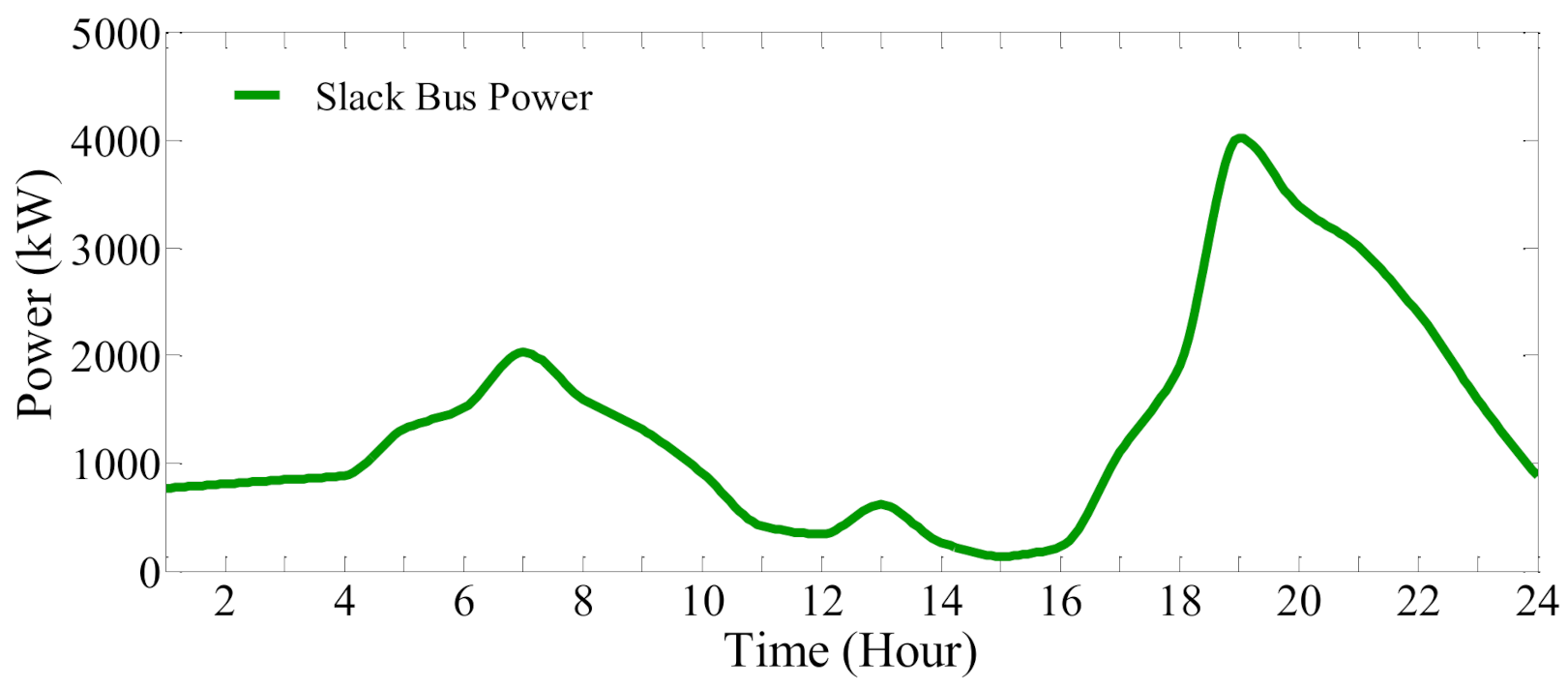
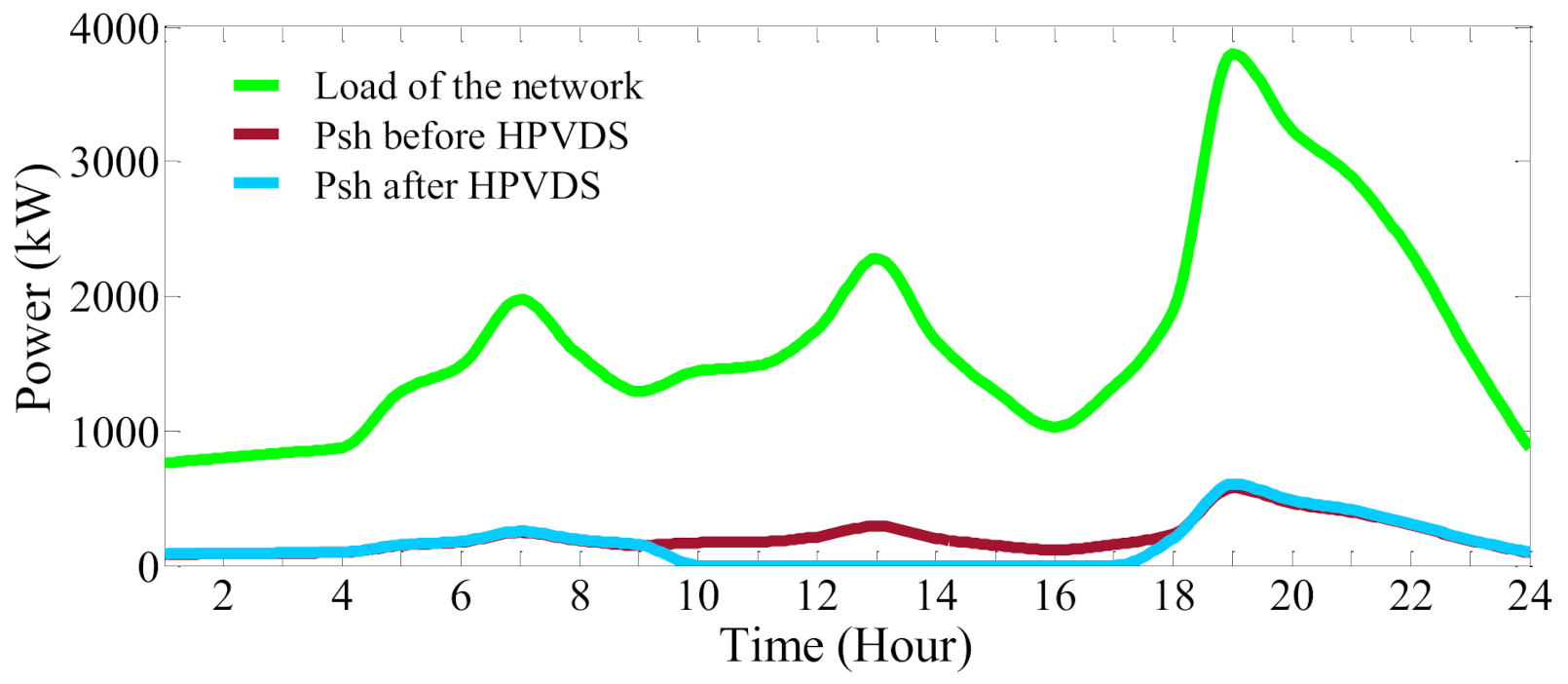
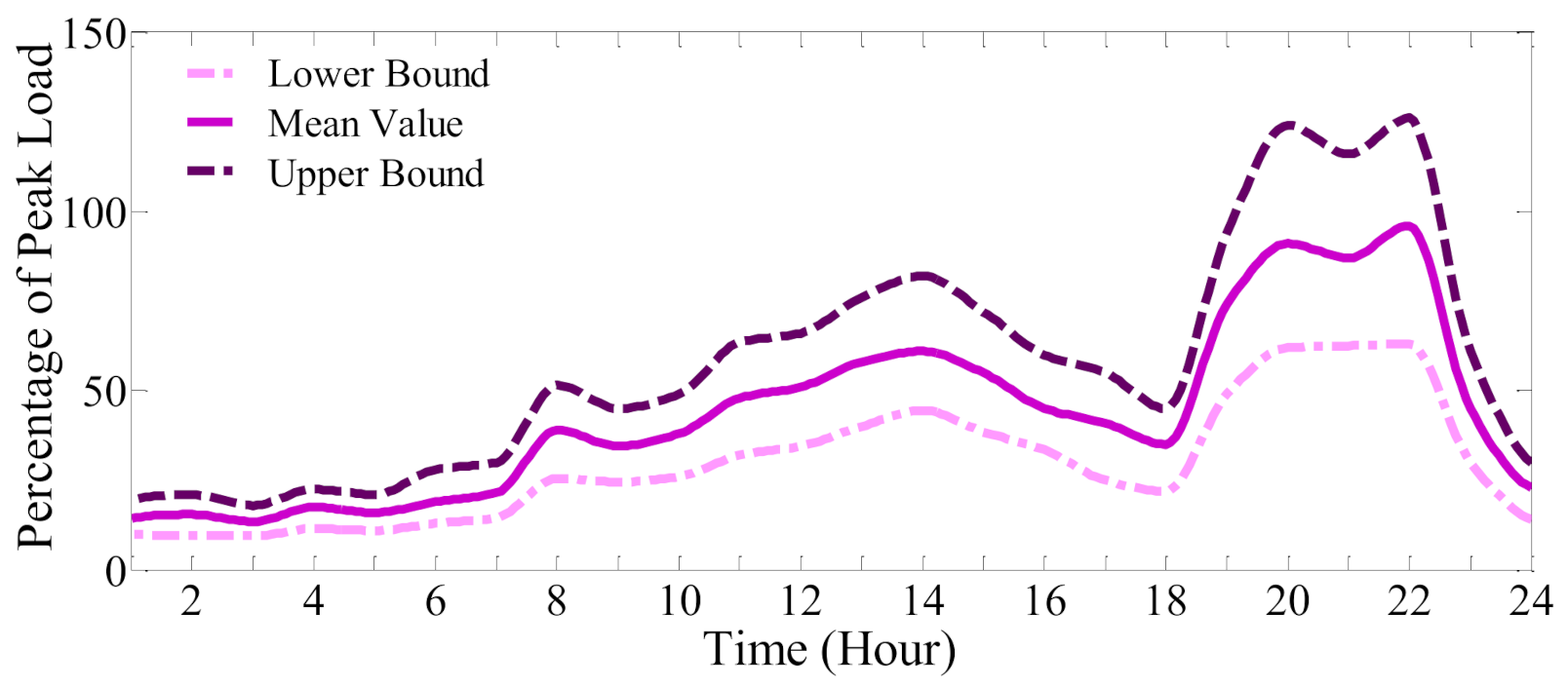
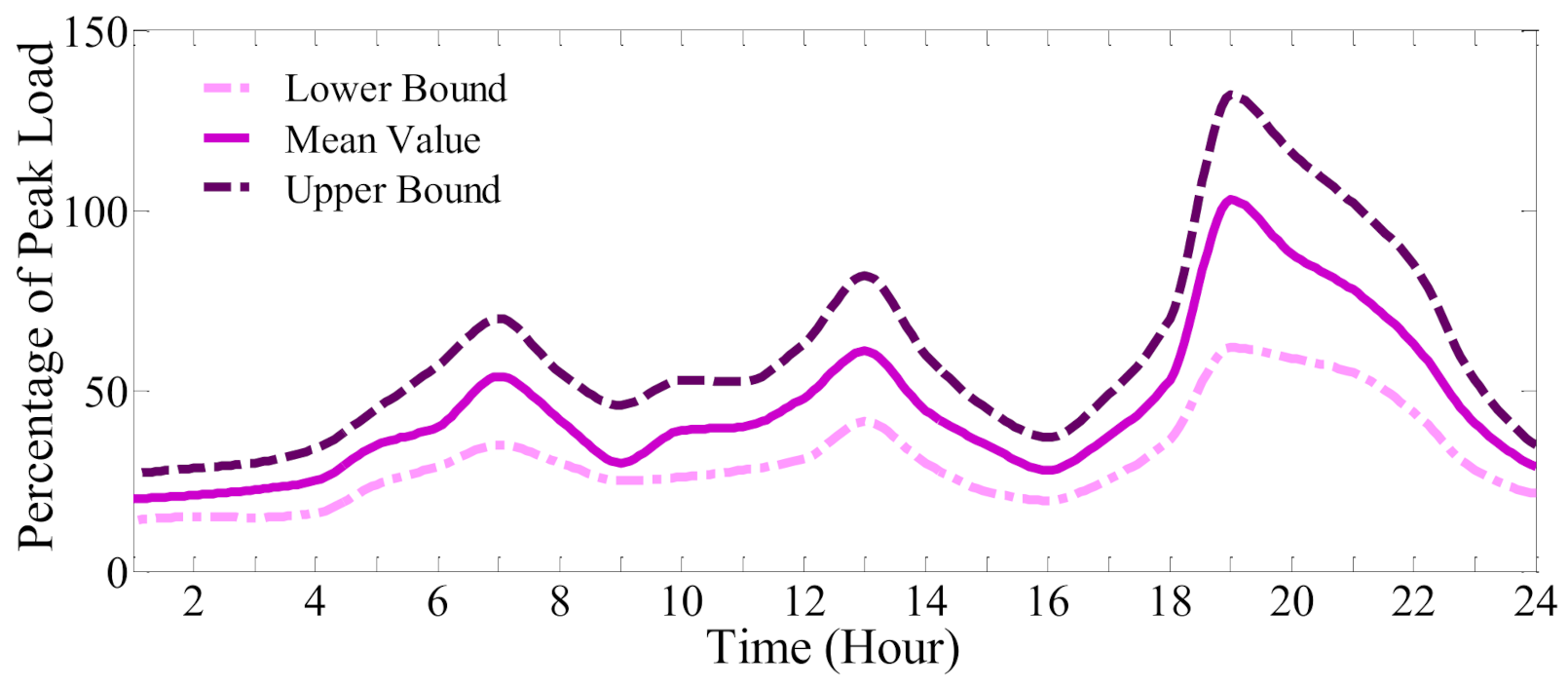
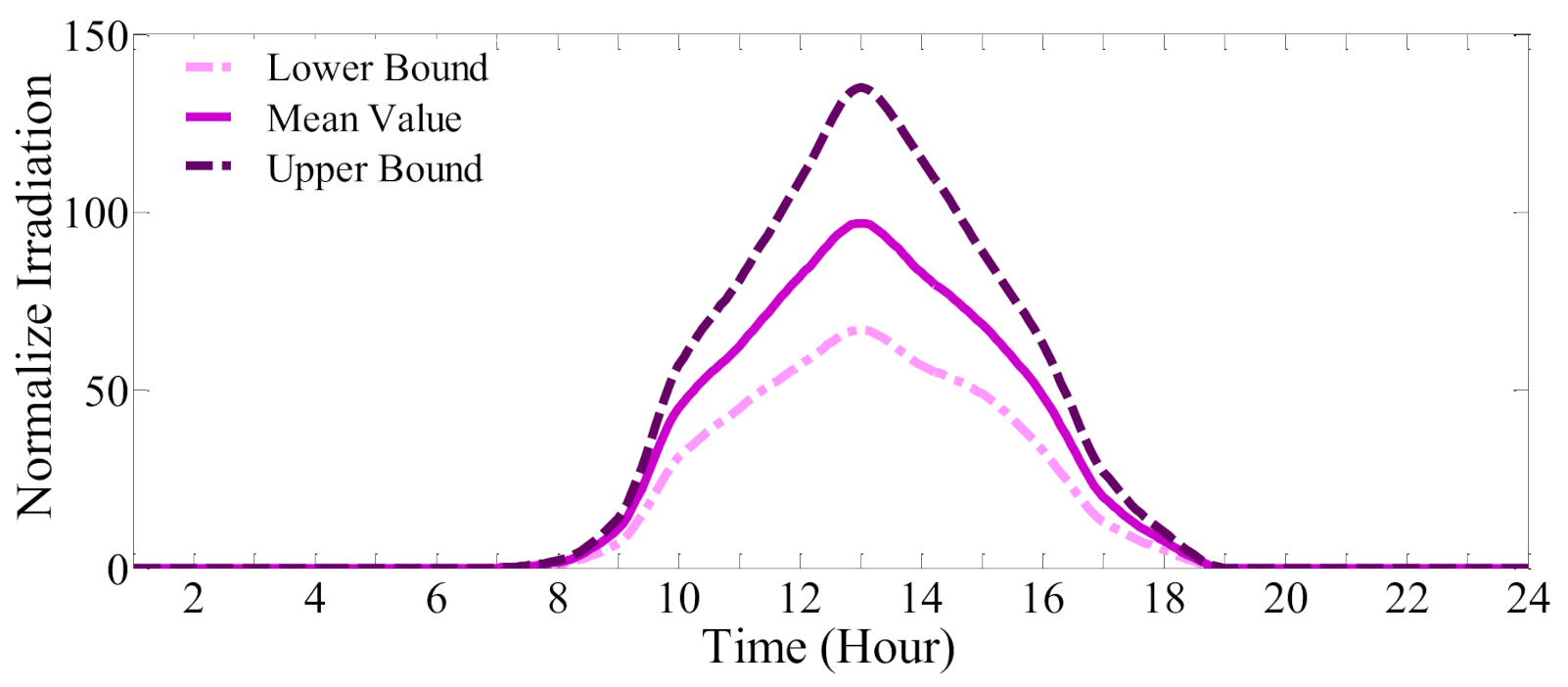
| Jan. | Feb. | Mar. | Apr. | May | Jun. | Jul. | Aug. | Sep. | Oct. | Nov. | Dec. |
|---|---|---|---|---|---|---|---|---|---|---|---|
| 5.45 | 5.73 | 6 | 6.01 | 5.65 | 5.26 | 4.81 | 4.78 | 5.15 | 5.63 | 5.84 | 5.57 |
| Load Level | Price of Residential Load (€/MW) | Price of Industrial Load (€/MW) | Percent of Peak Load |
|---|---|---|---|
| Low | 35 | 2000 | 50 < L |
| Middle | 49 | 2800 | 50 < L < 70 |
| Peak | 70 | 3050 | L > 70 |
| Bus | Method | Location | PV Size (Kw) | Diesel Size (Kw) | Number of Batteries | Cost (€) |
|---|---|---|---|---|---|---|
| 33 | LAPO | 6 | 395 | 242 | 25 | 47,162 |
| ABC | 26 | 393 | 242 | 25 | 47,383 | |
| 69 | LAPO | 59 | 400 | 256 | 26 | 50,360 |
| ABC | 61 | 399 | 238 | 25 | 52,351 |
| Bus | Location | PV Size | Diesel Size | Number of Batteries | Cost (€) |
|---|---|---|---|---|---|
| 33 | 2 | 395 | 215 | 42 | 70,342 |
| 69 | 6 | 400 | 214 | 39 | 69,214 |
| Bus | Location | PV Size | Diesel Size | Number of Batteries | Cost (€) |
|---|---|---|---|---|---|
| 33 | 2 | 395 | 253 | 37 | 59,802 |
| 69 | 2 | 400 | 265 | 34 | 59,325 |
Publisher’s Note: MDPI stays neutral with regard to jurisdictional claims in published maps and institutional affiliations. |
© 2021 by the authors. Licensee MDPI, Basel, Switzerland. This article is an open access article distributed under the terms and conditions of the Creative Commons Attribution (CC BY) license (https://creativecommons.org/licenses/by/4.0/).
Share and Cite
Nematollahi, A.F.; Shahinzadeh, H.; Nafisi, H.; Vahidi, B.; Amirat, Y.; Benbouzid, M. Sizing and Sitting of DERs in Active Distribution Networks Incorporating Load Prevailing Uncertainties Using Probabilistic Approaches. Appl. Sci. 2021, 11, 4156. https://doi.org/10.3390/app11094156
Nematollahi AF, Shahinzadeh H, Nafisi H, Vahidi B, Amirat Y, Benbouzid M. Sizing and Sitting of DERs in Active Distribution Networks Incorporating Load Prevailing Uncertainties Using Probabilistic Approaches. Applied Sciences. 2021; 11(9):4156. https://doi.org/10.3390/app11094156
Chicago/Turabian StyleNematollahi, Amin Foroughi, Hossein Shahinzadeh, Hamed Nafisi, Behrooz Vahidi, Yassine Amirat, and Mohamed Benbouzid. 2021. "Sizing and Sitting of DERs in Active Distribution Networks Incorporating Load Prevailing Uncertainties Using Probabilistic Approaches" Applied Sciences 11, no. 9: 4156. https://doi.org/10.3390/app11094156
APA StyleNematollahi, A. F., Shahinzadeh, H., Nafisi, H., Vahidi, B., Amirat, Y., & Benbouzid, M. (2021). Sizing and Sitting of DERs in Active Distribution Networks Incorporating Load Prevailing Uncertainties Using Probabilistic Approaches. Applied Sciences, 11(9), 4156. https://doi.org/10.3390/app11094156










